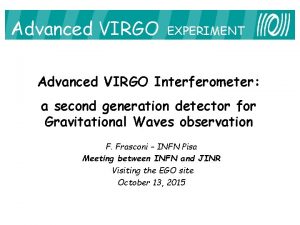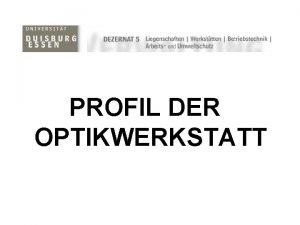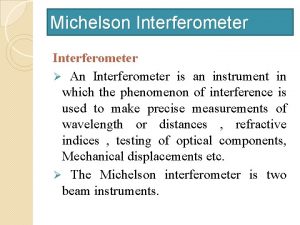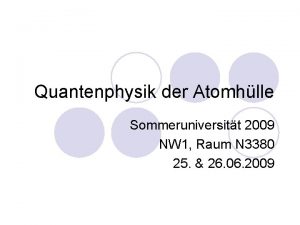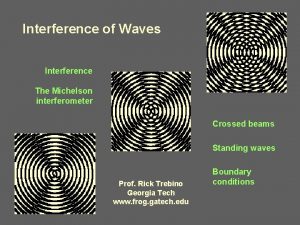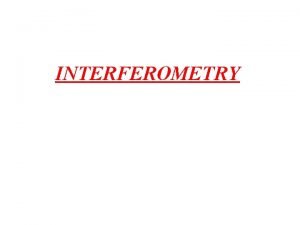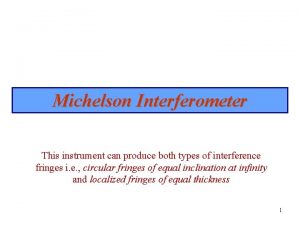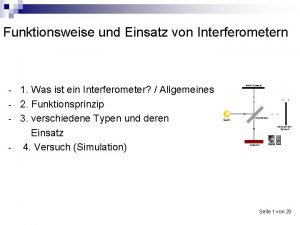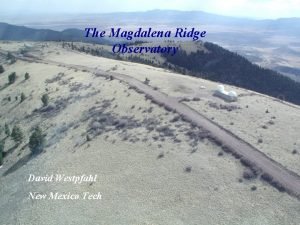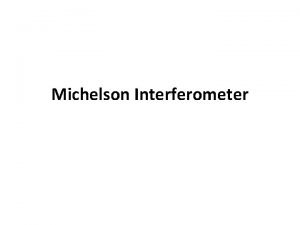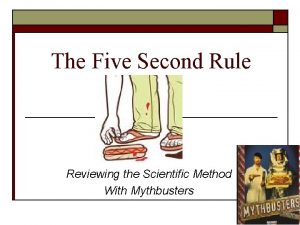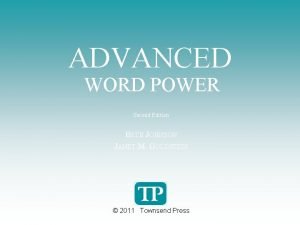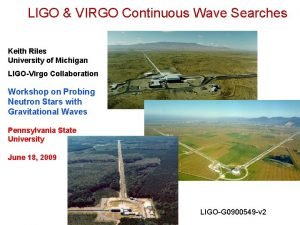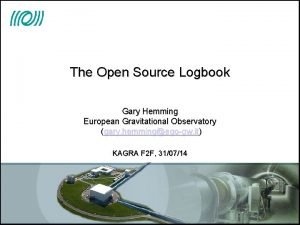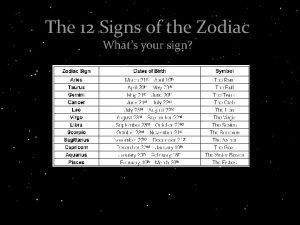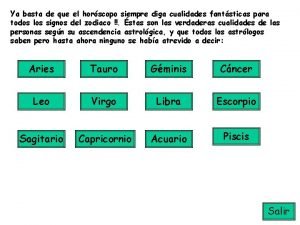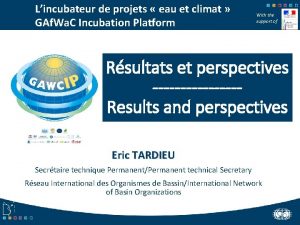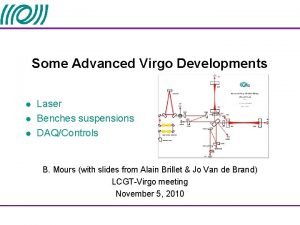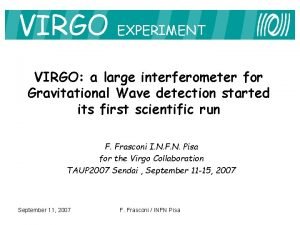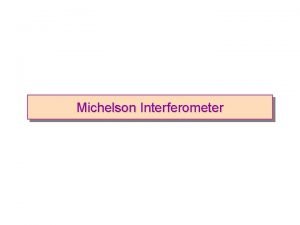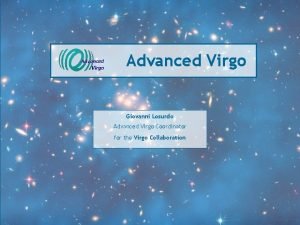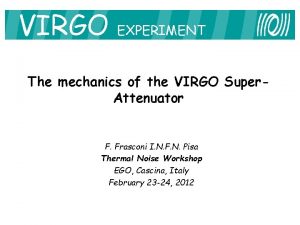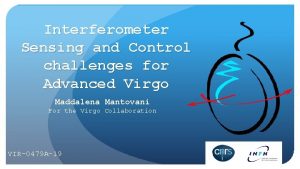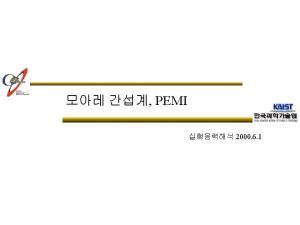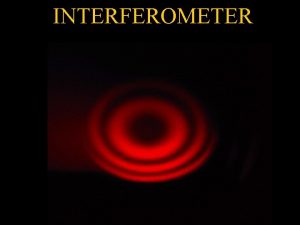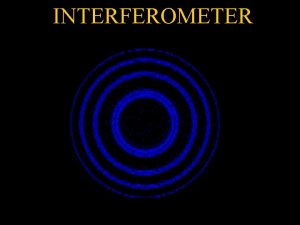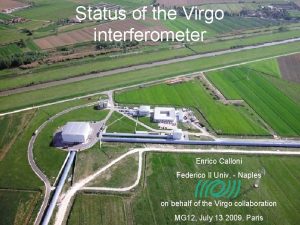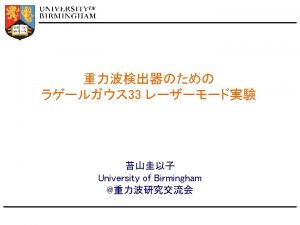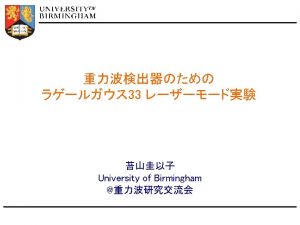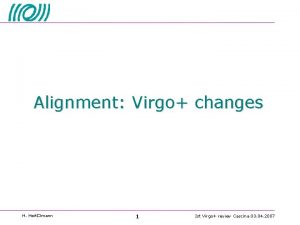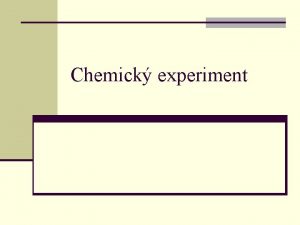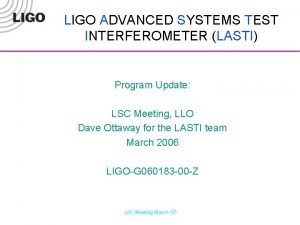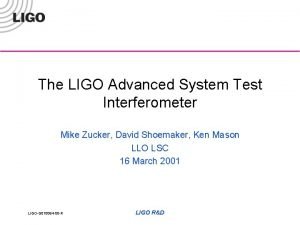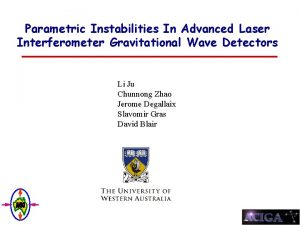Advanced VIRGO EXPERIMENT Advanced VIRGO Interferometer a second




























- Slides: 28

Advanced VIRGO EXPERIMENT Advanced VIRGO Interferometer: a second generation detector for Gravitational Waves observation F. Frasconi – INFN Pisa Meeting between INFN and JINR Visiting the EGO site October 13, 2015

The VIRGO Collaboration INFN – Italy CNRS – France Sez. Firenze/Un. Urbino Sez. Genova Sez. Napoli/Un. Federico II & Salerno Sez. Perugia/Un. Perugia & Camerino Sez. Pisa/Un. Pisa Sez. Roma/Un. Sapienza Sez. Roma 2/Un. Tor Vergata Sez. Padova/Un. Trento APC - Paris ESPCI - Paris LMA – Lyon LAL – Orsay LAPP - Annecy OCA – Nice EGO Group completes the Collaboration: about 200 authors October 13, 2015 NIKHEF – Amsterdam (NL) RADBOUND Un. Nijmegen POLGRAW – Warsaw (Pol) RMKI – Budapest (Hun) F. Frasconi / INFN Pisa 2

The Interferometer at EGO site Advanced VIRGO October 13, 2015 F. Frasconi / INFN Pisa 3

Gravitational Waves • According to the Einstein’s theory of General Relativity (1915), Gravitational Waves (GW) are perturbations of the “space-time” metric traveling in the Universe at the speed of light; • They are expected to be emitted by astrophysical processes in which accelerated coherent motions of large masses take place (supernova explosions, pulsars, etc. ); • The aim of ground based interferometric detectors (ITF) is the direct observation of GW together with the possibility to localize their source in the sky (detectors network). October 13, 2015 F. Frasconi / INFN Pisa 4

Importance of a detectors Network • False alarm rejection requires coincidence • Triangulation allows to pinpoint the source • The Network allows to deconvolve detector response and signal wave form -> measurement of the signal parameters • Longer observation time better sky coverage October 13, 2015 F. Frasconi / INFN Pisa 5

Network: ITFs of the 1 st Generation LIGO – HA USA GEO – 600 GER October 13, 2015 F. Frasconi / INFN Pisa LIGO – LI USA VIRGO Italy 6

The broad band GW interferometers • • The detector is sensitive to h the Gravitational Wave strain amplitude (a GW impinging on the plane of a suspended interferometer stretches one arm compressing the other one alternatively) The detector sensitivity is expressed in terms of the amplitude spectral density of the detector noise referred to its input H(f) [(Hz)-1/2] October 13, 2015 F. Frasconi / INFN Pisa 7

Sources of GW Coalescing Binary Systems Credit: AEI, CCT, LSU • Neutron stars, low mass black holes, and NS/BS systems ‘Bursts’ • galactic asymmetric core collapse supernovae • cosmic strings Credit: Chandra X-ray Observatory Cosmic GW background • Stochastic, incoherent background NASA/WMAP Science Team October 13, 2015 • unlikely to detect, but can bound in the 10 -10000 Hz range Casey Reed, Penn State F. Frasconi / INFN Pisa • ? ? ? Continuous Sources • Spinning neutron stars • probe crustal deformations, ‘quarki-ness’ 8

Advanced VIRGO Interferometer • Advanced VIRGO: upgrade of the VIRGO Interferometer • Michelson Interferometer with two Fabry-Perot cavities along the arms 3 km long each one October 13, 2015 F. Frasconi / INFN Pisa 9

Evolution of ITF sensitivity Virgo + Early Config. Late Config. October 13, 2015 F. Frasconi / INFN Pisa 10

Toward Ad. V operation • Start in 2015 putting in operation the ITF with a simplified configuration, similar to VIRGO+ : likely to reduce the commissioning time - without Signal Recycling mirror - VIRGO+ laser up to 60 W - low power (reduced risks with thermal effects and high power laser) • Target BNS inspiral range: > 100 Mpc October 13, 2015 F. Frasconi / INFN Pisa 11

Detector Design • Main changes with respect to VIRGO: - larger beam - heavier mirrors - higher quality optics - thermal control of aberrations - 200 W fiber laser - Signal Recycling • Vibration isolation by VIRGO Superattenuators: - performance compliant with new requirements - wide experience with commissioning at low frequency October 13, 2015 F. Frasconi / INFN Pisa 12

Seismic Noise • Seismic noise limits sensitivity of ground based detectors at low frequencies - “seismic wall” • Typical seismic noise at EGO site at 10 Hz is ~ few x 10 -10 m/ Hz – many orders of magnitude above target noise level Better Isolation • Solution – isolation system with a multi-stages pendulum • Isolation required in vertical direction as well as horizontal due to cross-coupling (triangular cantilever blades) October 13, 2015 Advantages of a double over single pendulum, same overall length F. Frasconi / INFN Pisa 13

Mirror Suspensions • The Superattenuator (SA) is the mechanical system adopted to isolate the optical components from seismic activities (local disturbances). It is based on the working principle of a multistage pendulum; • Hybrid system: active control below 4 Hz and passive attenuation starting from 4 Hz. October 13, 2015 F. Frasconi / INFN Pisa 14

Passive mechanical filters Cantilever blades (made of Maraging steel) used as elastic elements to provide seismic isolation along the vertical direction October 13, 2015 F. Frasconi / INFN Pisa 15

The SA chain • The Inverted Pendulum (IP) is a pre-isolator stage (cut-off frequency @ 40 m. Hz) conceived to allow a wide positioning control of the suspension point in 6 d. o. f. • It plays a crucial role on the hierarchical control of the suspension (control of tidal strain and drift of any origin – up to 200 m. Hz) October 13, 2015 F. Frasconi / INFN Pisa 16

Main features of SA Signals to the actuators LVDT Signals ADC Acc. Signals October 13, 2015 DSP Passive attenuation chain + Active Mode Damping Standard Filters DAC Residual swing at Payload level LONGITUDINAL: about 100 nm pp ANGLES: fractions of µrad pp F. Frasconi / INFN Pisa 17

Activities on SA for Ad. V • Different spatial distribution of the mechanical filters along the suspension chain (optimization of seismic noise filtering in accordance with a new geometry of the Intermediate Vacuum Chamber) • Re-tuning of mechanical filters in accordance with the load to be supported (heavier mirrors + new TCS + baffles) • Re-design and construction of the last mechanical filter (Filter 7) in accordance with the new Payloads geometry (presence of large baffle for diffused light mitigation) • Construction of new control electronics: - analog and digital parts embedded in a single board - about 100 channels per SA October 13, 2015 F. Frasconi / INFN Pisa 18

Mirror Suspension Comparison VIRGO October 13, 2015 Seismic Filters spatial distribution F. Frasconi / INFN Pisa Ad. V 19

Ad. V Payloads • • The new Payload geometry include: - heavier mirrors (42 kg – 350 mm diameter) - larger diameter (BS – 550 mm) - baffle for diffused light mitigation - compensation plate (complex TCS system) Test masses suspended with Silica Fibers for thermal noise reduction (Monolithic suspension as in VIRGO+) October 13, 2015 F. Frasconi / INFN Pisa 20

Stray light mitigation • Lesson from 1 st generation detector: scattered light is one of the major risks towards the final sensitivity goal • A big effort has been done to mitigate it: - better optics quality - baffles to shield mirrors, pipes, vacuum chamber exposed to scattered light - photodiodes suspended in vacuum to isolate them from seismic/acoustic noise - if needed, control the position of the benches with respect to the ITF October 13, 2015 F. Frasconi / INFN Pisa 21

Status of Ad. V • First important milestone achieved June 19 th, 2014: robust locking of the IMC (Input Mode Cleaner cavity – 145 m long) and commissioning started; • Progress in the SA upgrades and payloads installation: - monolithic IP installed on 5 SA (BS, WI, NI, PR, SR) - payloads integrated in BS, WI, NI 54 W output Laser Source October 13, 2015 F. Frasconi / INFN Pisa 22

Status of Ad. V (cont. ) Second input test mass (NI) suspended in July (common effort of: INFN Roma 1, INFN PG, INFN Tor Vergata, INFN PI, EGO) October 13, 2015 F. Frasconi / INFN Pisa 23

Status of Ad. V (cont. ) • Production of Ad. V large mirrors completed: - large BS mirror (550 mm diameter) - heavier test masses (about 42 kg) October 13, 2015 F. Frasconi / INFN Pisa 24

Status of Ad. V (cont. ) All 5 minitowers and 3 SMAS have been installed; First minitower bench (SIB 2) integrated October 13, 2015 F. Frasconi / INFN Pisa 25

Network: ITFs of the 2 nd Generation a. LIGO-HA a. LIGO-LI October 13, 2015 GEO-HF KAGRA Advanced VIRGO F. Frasconi / INFN Pisa a. LIGO-India 26

2 nd Generation Network Source localization in the sky October 13, 2015 F. Frasconi / INFN Pisa 27

Conclusions • Still waiting for the first detection … • Fundamental experience acquired with the 1 st generation of ground based ITF: - wide experience collected in operating sophisticated detectors - important results obtained with collected data • The construction of the Advanced Detectors (target sensitivity 10 times better) is in progress: - end of Ad. V installation in the fall of 2015 • They will increase of a factor 103 the observable volume of the Universe opening the phase of the GW astronomy October 13, 2015 F. Frasconi / INFN Pisa 28
 Virgo experiment
Virgo experiment Optikwerkstatt
Optikwerkstatt What is the principle of michelson interferometer
What is the principle of michelson interferometer Laser interferometer space antenna
Laser interferometer space antenna Dreidimensionaler potentialtopf
Dreidimensionaler potentialtopf Constructive vs destructive interference
Constructive vs destructive interference Pitter npl gauge interferometer
Pitter npl gauge interferometer Types of fringes in michelson interferometer
Types of fringes in michelson interferometer Weißlichtinterferometer funktionsweise
Weißlichtinterferometer funktionsweise Magdalena ridge observatory interferometer
Magdalena ridge observatory interferometer Prinsip kerja interferometer michelson
Prinsip kerja interferometer michelson 5 second rule science experiment
5 second rule science experiment 186 282 miles per second into meters per second
186 282 miles per second into meters per second Ten steps to advanced reading 2nd edition answers
Ten steps to advanced reading 2nd edition answers Advanced word power second edition answers
Advanced word power second edition answers Keith virgo
Keith virgo Memento mori frase completa
Memento mori frase completa Virgo weebly geschiedenis
Virgo weebly geschiedenis Virgo logbook
Virgo logbook Sola pith aptae viris
Sola pith aptae viris Mythical creature
Mythical creature Horscopo
Horscopo Virgo proof of concept
Virgo proof of concept Memoria concreet 5 oplossingen
Memoria concreet 5 oplossingen Laniakea supercluster
Laniakea supercluster Virgo
Virgo Uva virgo library
Uva virgo library Virgo
Virgo Virgo proof of concept
Virgo proof of concept
